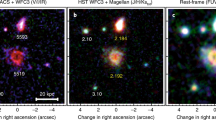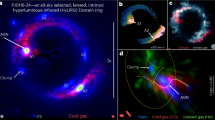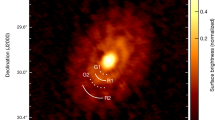Abstract
Hitherto, rings have been found exclusively around the four giant planets in the Solar System1. Rings are natural laboratories in which to study dynamical processes analogous to those that take place during the formation of planetary systems and galaxies. Their presence also tells us about the origin and evolution of the body they encircle. Here we report observations of a multichord stellar occultation that revealed the presence of a ring system around (10199) Chariklo, which is a Centaur—that is, one of a class of small objects orbiting primarily between Jupiter and Neptune—with an equivalent radius of 124  9 kilometres (ref. 2). There are two dense rings, with respective widths of about 7 and 3 kilometres, optical depths of 0.4 and 0.06, and orbital radii of 391 and 405 kilometres. The present orientation of the ring is consistent with an edge-on geometry in 2008, which provides a simple explanation for the dimming3 of the Chariklo system between 1997 and 2008, and for the gradual disappearance of ice and other absorption features in its spectrum over the same period4,5. This implies that the rings are partly composed of water ice. They may be the remnants of a debris disk, possibly confined by embedded, kilometre-sized satellites.
9 kilometres (ref. 2). There are two dense rings, with respective widths of about 7 and 3 kilometres, optical depths of 0.4 and 0.06, and orbital radii of 391 and 405 kilometres. The present orientation of the ring is consistent with an edge-on geometry in 2008, which provides a simple explanation for the dimming3 of the Chariklo system between 1997 and 2008, and for the gradual disappearance of ice and other absorption features in its spectrum over the same period4,5. This implies that the rings are partly composed of water ice. They may be the remnants of a debris disk, possibly confined by embedded, kilometre-sized satellites.
This is a preview of subscription content, access via your institution
Access options
Subscribe to this journal
Receive 51 print issues and online access
$199.00 per year
only $3.90 per issue
Buy this article
- Purchase on SpringerLink
- Instant access to full article PDF
Prices may be subject to local taxes which are calculated during checkout



Similar content being viewed by others
References
Tiscareno, M. S. in Planets, Stars and Stellar Systems Vol. 3 Solar and Stellar Planetary Systems (eds Oswalt, T. D., French, L. M. & Kalas, P. ) 309–375 (Springer, 2013)
Fornasier, S. et al. TNOs are cool: A survey of the trans-Neptunian region VIII. Combined Herschel PACS and SPIRE observations of nine bright targets at 70–500 µm. Astron. Astrophys. 555, A15 (2013)
Belskaya, I. N. et al. Polarimetry of Centaurs (2060) Chiron, (5145) Pholus and (10199) Chariklo. Icarus 210, 472–479 (2010)
Guilbert, A. et al. A portrait of Centaur 10199 Chariklo. Astron. Astrophys. 501, 777–784 (2009)
Guilbert-Lepoutre, A. A thermal evolution model of Centaur 10199 Chariklo. Astron. J. 141, 103 (2011)
Horner, J., Evans, N. W. & Bailey, M. E. Simulations of the population of Centaurs - I. The bulk statistics. Mon. Not. R. Astron. Soc. 354, 798–810 (2004)
Camargo, J. I. B. et al. Candidate stellar occultations by Centaurs and trans-Neptunian objects up to 2014. Astron. Astrophys. 561, A37 (2014)
Harpsøe, K. B. W., Jørgensen, U. G., Andersen, M. I. & Grundahl, F. High frame rate imaging based photometry. Photometric reduction of data from electron-multiplying charge coupled devices (EMCCDs). Astron. Astrophys. 542, A23 (2012)
Skottfelt, J. et al. EMCCD photometry reveals two new variable stars in the crowded central region of the globular cluster NGC 6981. Astron. Astrophys. 553, A111 (2013)
French, R. G., Nicholson, P. D., Porco, C. C. & Marouf, E. A. in Uranus (eds Bergstralh, J. T., Miner, E. D. & Matthews, M. S. ) 327–409 (Univ. Arizona Press, 1991)
Colwell, J. E. et al. in Saturn from Cassini-Huygens (eds Dougherty, M. K., Esposito, L. W. & Krimigis, S. M. ) 375–412 (Springer, 2009)
Esposito, L. W., Brahic, A., Burns, J. A. & Marouf, E. A. in Uranus (eds Bergstralh, J. T., Miner, E. D. & Matthews, M. S. ) 410–465 (Univ. Arizona Press, 1991)
Karkoschka, E. Comprehensive photometry of the rings and 16 satellites of Uranus with the Hubble Space Telescope. Icarus 151, 51–68 (2001)
Hedman, M. M. et al. Connections between spectra and structure in Saturn’s main rings based on Cassini VIMS data. Icarus 223, 105–130 (2013)
Tiscareno, M. S., Hedman, M. M., Burns, J. A. & Castillo-Rogez, J. Compositions and origins of outer planet systems: insights from the Roche critical density. Astrophys. J. 765, L28 (2013)
Goldreich, P. & Tremaine, S. Towards a theory for the Uranian rings. Nature 277, 97–99 (1979)
Elliot, J. L. et al. Size and albedo of Kuiper belt object 55636 from a stellar occultation. Nature 465, 897–900 (2010)
Sicardy, B. et al. A Pluto-like radius and a high albedo for the dwarf planet Eris from an occultation. Nature 478, 493–496 (2011)
Ortiz, J. L. et al. Albedo and atmospheric constraints of dwarf planet Makemake from a stellar occultation. Nature 491, 566–569 (2012)
Braga-Ribas, F. et al. The size, shape, albedo, density, and atmospheric limit of Transneptunian object (50000) Quaoar from multi-chord stellar occultations. Astrophys. J. 773, 26 (2013)
Bus, S. J. et al. Stellar occultation by 2060 Chiron. Icarus 123, 478–490 (1996)
Elliot, J. L. et al. Jet-like features near the nucleus of Chiron. Nature 373, 46–49 (1995)
Brunini, A. On the dynamical evolution and end states of binary Centaurs. Mon. Not. R. Astron. Soc. 437, 2297–2302 (2014)
Noll, K. S., Grundy, W. M., Chiang, E. I., Margot, J.-L. & Kern, S. D. in The Solar System Beyond Neptune (eds Barucci, M. A., Boehnhardt, H., Cruikshank, D. P. & Morbidelli, A. ) 345–363 (Univ. Arizona Press, 2008)
Ortiz, J. L. et al. Rotational fission of trans-Neptunian objects: the case of Haumea. Mon. Not. R. Astron. Soc. 419, 2315–2324 (2012)
Ćuk, M., Ragozzine, D. & Nesvorný, D. On the dynamics and origin of Haumea’s moons. Astron. J. 146, 89 (2013)
Nogueira, E., Brasser, R. & Gomes, R. Reassessing the origin of Triton. Icarus 214, 113–130 (2011)
Acknowledgements
We thank S. Fornasier, I. Belskaya, B. Carry, E. Nogueira, P. Michel and A. Morbidelli for the discussions that helped to interpret our results. We also thank J. A. Burns for comments that helped to improve the paper. F.B.-R. acknowledges LIneA (Laboratório Interinstitucional de e-Astronomia) for hosting the campaign webpage and the support (grant 150541/2013-9) of CNPq, Brazil. Operation of the Danish 1.54-m telescope is financed by a grant to U.G.J. by the Danish Natural Science Research Council (FNU) and by the Centre for Star and Planet Formation (StarPlan). F. Colas, J.L., L. Maquet, F. Roques, B.S., F.V. and T.W. acknowledge support from the French grant ‘Beyond Neptune II’. J.L.O., R.D. and N. Morales acknowledge funding from Spanish AYA grants and FEDER funds. S.-h.G. and X.-b.W. are grateful for financial support from the National Natural Science Foundation of China through grants 10873031 and 11073051. M.D. is a Royal Society University Research Fellow at St Andrews University. TRAPPIST is a project funded by the Belgian Fund for Scientific Research (FRS-FNRS) with the participation of the Swiss National Science Foundation (SNF). E.J. and M.G. are FNRS Research Associates, J.M. is FNRS Research Director. C.O. thanks the Belgian FNRS for funding her PhD thesis. J.I.B.C., M.A. and R.V.-M. acknowledge CNPq grants 302657/2010-0, 482080/2009-4 478318/2007-3 and 304124/2007-9, respectively. The Universidad Católica Observatory (UCO) Santa Martina is operated by the Pontifícia Universidad Católica de Chile (PUC). C.S. received funding from the European Union Seventh Framework Programme (FP7/2007-2013) under grant agreement no. 268421. M.R. acknowledges support from FONDECYT postdoctoral fellowship 3120097. This work is partly based on observations made at the Pico dos Dias Observatory from the National Laboratory of Astrophysics (OPD/LNA) – Brazil; and partly based on observations obtained at the Southern Astrophysical Research (SOAR) telescope, which is a joint project of the Ministério da Ciência, Tecnologia, e Inovação (MCTI) da República Federativa do Brasil, the US National Optical Astronomy Observatory (NOAO), the University of North Carolina at Chapel Hill (UNC-CH) and Michigan State University (MSU). This publication makes use of data products from the Two Micron All Sky Survey, a joint project of the University of Massachusetts and the Infrared Processing and Analysis Center/California Institute of Technology, funded by the National Aeronautics and Space Administration (NASA) and the National Science Foundation (NSF). It also makes use of data products from the Wide-field Infrared Survey Explorer, which is a joint project of the University of California, Los Angeles, and the Jet Propulsion Laboratory/California Institute of Technology, funded by NASA. UNC-CH gratefully acknowledges NSF awards 0959447, 1009052 and 1211782 for support of Skynet/PROMPT. L.V. and R.L. acknowledge support by CONICYT through the project Anillo ACT-86. A.M. acknowledges the use of C. Harlingten’s 20-inch Planewave telescope, which is part of the Searchlight Observatory Network.
Author information
Authors and Affiliations
Contributions
F.B.-R. planned the observation campaign, centralized the occultation predictions, participated in the observations, analysed data and results, ran the diffraction and limb-fitting codes, and wrote the paper. B.S. helped to plan the campaign, analysed data and results, wrote and ran the diffraction and limb-fitting codes, and wrote the paper. J.L.O. helped to plan the campaign, analysed data for the occultation prediction, and obtained and analysed data and results. C.S. coordinated and analysed the data from Danish 1.54-m telescope. F. Roques analysed data, and wrote and ran the diffraction and limb-fitting codes. R.V.-M. coordinated the predictions and analysed data. J.I.B.C., F.B.-R., R.V.-M. and M.A. discovered the star candidate and analysed data for the occultation prediction. R.D. coordinated the SOAR and Bosque Alegre observations, and helped to analyse the results. E.J., J.P, R.L., M.E., D.I.M., C.C. and J. Spagnotto obtained and analysed the positive occultation detections from the TRAPPIST, PROMPT, UCO Santa Martina, UEPG, Foz do Iguaçu, Bosque Alegre and Danish telescopes, respectively. E.L. helped to analyse the results. J. Skottfelt, M.G., L. Maquet, N.L., G.B.-R. and A.R.G. helped to obtain the occultation light curves or analysed the data, or both. P.K. ran stellar models to determine the apparent star diameter. H.M. obtained the stellar spectrum. R.S. calculated the short-term ring stability. M.E.M. worked on the confinement mechanisms of the rings. G.T., J.P., A.M., N. Morales, R.G.-H., S.R. and A.C. obtained the negative detections. S.-h.G., X.-b.W., K.H., M.R., J.M., C.O., L.V., L. Mehret, L.L., E.M.S. and R.M. helped to obtain and analyse the positive occultation detections. J.L., F. Colas, F.V., T.W. and K.H. helped to make the predictions and analyse the data. L.A., R.G.S., F. Char, V.P., P.L., N. Martinez, U.G.J., M.D., F. Roig, D.E.R., A.P.L., J.B.H., K.M.I., J.P.M., N.R.F. and D.G.L. were involved in event observations. All authors were given the opportunity to review the results and comment on the manuscript.
Corresponding author
Ethics declarations
Competing interests
The authors declare no competing financial interests.
Extended data figures and tables
Extended Data Figure 1 The Chariklo 3 June 2013 occultation campaign.
The continuous straight lines indicate Chariklo’s shadow track on Earth, and the dotted lines correspond to the ring shadow, as reconstructed from our post-occultation analysis. The shadows move from right to left, as indicated. The red stars indicate the centre of Chariklo’s shadow at various times (utc). The green dots are the sites where the occultation was detected. The blue dots are the sites that had obtained data but did not detect the event, and the white ones are the sites that were clouded out (Extended Data Table 1).
Extended Data Figure 2 The occulted star spectrum and model.
The star spectrum obtained at Pico dos Dias Observatory, Brazil, with the 1.6-m telescope and a Cassegrain spectrograph. Observations were made with the spectrograph configuration, using a grating with 600 lines per millimetre, which gave a resolution of 2.3 Å per pixel covering 3,700–7,700 Å. We obtained three 300-s exposures with a 2-arcsec slit. The calibration was done with the usual procedures and one flux standard star (LTT6248). The thick blue curve represents the observed spectrum. The red, orange and blue thin curves represent ATLAS9 stellar atmosphere models35 used for comparison (see text).
Extended Data Figure 3 The fits to all the ring and Chariklo events.
The black dots are the data points and the horizontal bars indicate the corresponding intervals of acquisition. The light curves are normalized between zero and unity (the latter corresponding to the full flux from the star plus Chariklo), and are shifted vertically for better viewing. They are also displaced in time by the indicated amount Δt, to align the middles of the ring events. The blue curves represent the ring model used to generate the synthetic profiles, which are plotted in red. The ring widths and optical depths for La Silla (Danish and TRAPPIST telescopes) are taken from Extended Data Table 3. For all the other fits, we have used a unique ring model defined by the ring geometry described in Extended Data Table 4, and by the following widths and optical depths: WC1R = 6.6 km, τN,C1R = 0.38, WC2R = 3.4 km and τN,C2R = 0.06 (Extended Data Table 2). An expanded view of the fits to the Danish data is provided in Fig. 3.
Supplementary information
Supplementary Information
This file contains Supplementary Text and References. (PDF 288 kb)
Rights and permissions
About this article
Cite this article
Braga-Ribas, F., Sicardy, B., Ortiz, J. et al. A ring system detected around the Centaur (10199) Chariklo. Nature 508, 72–75 (2014). https://doi.org/10.1038/nature13155
Received:
Accepted:
Published:
Issue Date:
DOI: https://doi.org/10.1038/nature13155
This article is cited by
-
A planetary ring in a surprising place
Nature (2023)
-
Trojan Asteroid Satellites, Rings, and Activity
Space Science Reviews (2023)
-
A dense ring of the trans-Neptunian object Quaoar outside its Roche limit
Nature (2023)
-
The fate of particles in the dynamical environment around Kuiper-Belt object (486958) Arrokoth
Astrophysics and Space Science (2022)
-
Extended use of the Ariel Core Survey Data
Experimental Astronomy (2022)



